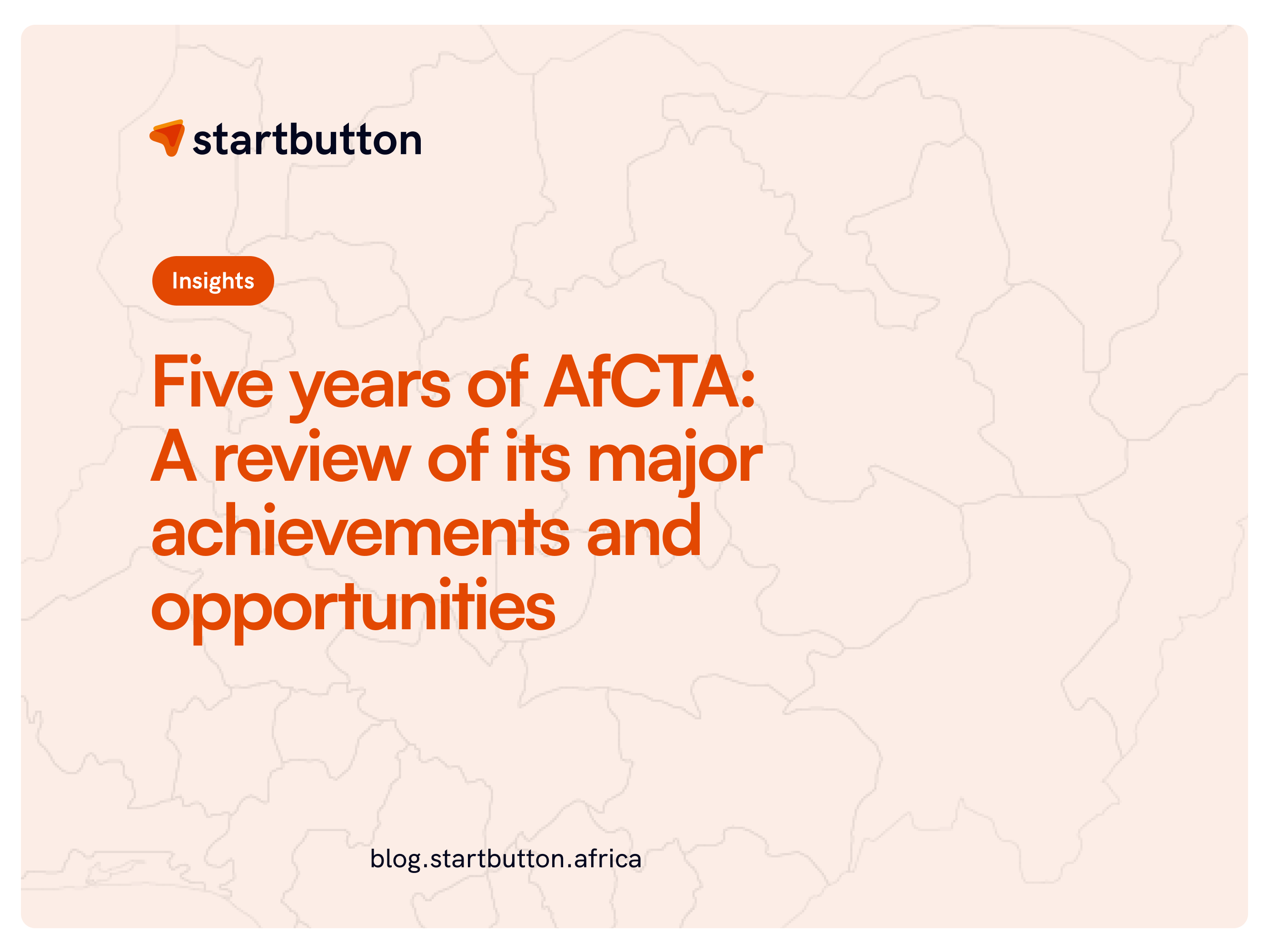At the recent Africa CEO Conference, in a moderated panel discussion, Aliko Dangote, CEO of Dangote Industries, raised some concerns about the efficiency of the Africa Continental Free Trade Area (AfCFTA) agreement whose enforcement began over 5 years ago today. The richest man in Africa pointed out some apparent constraints that persist when trading within the continent despite the AfCFTA agreement which was created to address these concerns.
“We need to make sure that it (AFcTA agreement) works. We cannot have a promising continent and our intra-trade (volume) is less than 16%,” Dangote said.
Many stakeholders share the same sentiment that the AfCFTA agreement is not working nearly as optimally as it was designed to over five years ago. This is owing to a plethora of issues, including ongoing negotiations and legislative restrictions which have led to a lack of proper implementation of the agreement’s details.
In this article, we review the efficacy of the AfCFTA agreement on its fifth anniversary.
What is the AfCFTA agreement all about?
The African Continental Free Trade Area (AfCFTA) is a one-of-a-kind trade agreement to establish the largest free trade zone in the world. This free trade zone would cover the entirety of the African continent, creating a unified market for goods and services for the 1.3 billion people across Africa. This initiative is designed to facilitate economic integration across the continent. The AfCFTA’s objectives include reducing tariffs among member states and addressing policies that hinder the intra-trade potential of the African continent.
Although the agreement received its most recent Instrument of Ramification in May 2022, members are committed to eliminating tariffs on goods and services over 5-13 years, covering at least three distinct negotiation phases. Over the last few years, the AfCTA has accomplished a few notable things.
Achievements of the AfCFTA since its inception
Negotiation progress
For one, relevant negotiations have been going smoothly. The first round of negotiations has been completed birthing an agreement on protocols related to trade in goods and services and settlement of disputes, permitting the launch of trading. Phase II of negotiations regarding intellectual property rights and competition policy are underway.
Negotiations are also ongoing to remove tariffs on 90% of goods over 5-10 years. For another 7% of goods considered “sensitive,” tariffs will be removed over a 10-13 year period.
AfCFTA Guided Trade Initiative
In September/October 2022, the “AfCFTA Guided Trade Initiative” was launched as a pilot program to see if certain African countries were ready to trade under the new African Continental Free Trade Area rules. The goal was to test the new procedures and documents by having these countries trade important goods with each other at reduced tariffs. The initiative involved eight countries from five different regions of Africa: Cameroon, Ghana, Egypt, Tanzania, Kenya, Rwanda, Mauritius, and Tunisia, representing the different African regions.
Although most of the products traded under the Guided Trade Initiative were low-value goods, mainly agricultural products like coffee and tea (except Exide batteries from Kenya to Ghana), this move represents a positive step for the future of the AfCTFA
AfCFTA Dispute Settlement Body Operationalised
On April 26, 2021, the AfCFTA Dispute Settlement Body held its inaugural meeting at the AfCFTA Secretariat. This pivotal moment marked the operationalisation of the body designed to handle disputes arising under the AfCFTA agreement, providing a structured mechanism for resolving trade disagreements and ensuring the smooth implementation of the agreement’s provisions
Launch of the Pan African Payment and Settlement System (PAPSS)
At the beginning of 2022, the Pan African Payment and Settlement System (PAPSS) was launched. This system, crucial for facilitating efficient and secure cross-border payments within Africa, aims to boost intra-African trade by reducing the dependency on foreign currencies and streamlining payment processes between African nations.
During the 54th Conference of African Ministers of Finance, Planning, and Economic Development in May 2022, the AfCFTA unveiled the ATEX platform. This Business-to-Business (B2B) tool is specifically designed to help African businesses find new markets within the continent. By focusing on the trade of basic commodities essential for production and supply chains, ATEX aims to foster economic growth and collaboration among African enterprises.
Launch of Trade Barriers Africa
Earlier, on January 13, 2020, AfCFTA introduced “Trade Barriers Africa,” a continental mechanism aimed at identifying and eliminating non-tariff barriers to trade. This initiative is a critical step towards creating a more conducive environment for trade by addressing issues that hinder the free flow of goods and services across African borders.
Unveiling of the AfCTFA Glossary
In 2022, the AfCFTA Secretariat, in collaboration with the International Trade Centre (ITC), launched the AfCFTA Glossary. This comprehensive resource was developed to provide clarity and consistency in the terminology used within the AfCFTA framework. However, despite its importance, the glossary has yet to be made available online, limiting its accessibility to stakeholders across the continent. These milestones represent significant strides in the quest for deeper economic integration and enhanced trade across Africa. As the AfCFTA continues to implement its ambitious agenda, these foundational achievements set the stage for a more unified and prosperous African economy.
Hurdles for International Businesses in AfCFTA
The African Continental Free Trade Area (AfCFTA) offers great opportunities for international businesses looking to expand in Africa. However, navigating the legal landscape can be challenging. Here are some key legal issues international companies may face in the AfCFTA region:
- Tariff and Non-Tariff Barriers: While AfCFTA aims to eliminate tariffs on most goods, non-tariff barriers like customs procedures, import restrictions, and varying regulatory standards can still hinder trade. Companies need to ensure compliance with different national regulations.
- Intellectual Property Rights: Protecting intellectual property (IP) is difficult due to varying IP laws and enforcement across African countries. Corporations must take measures to protect their IP while adapting to local laws.
- Dispute Resolution: Resolving disputes can be complex for companies operating in multiple AfCFTA member states. Although AfCFTA has a Dispute Settlement Mechanism, its effectiveness is yet to be fully tested.
- Inconsistent Legal Frameworks: Different legal systems in AfCFTA member states make it challenging to navigate the legal environment. Understanding local laws, regulations, and business practices is essential.
- Regulatory Compliance: Each member state has its own regulatory requirements. International companies must be ready to meet various regional rules and standards.
- Taxation and Customs: Tax systems vary significantly across countries. Companies must understand the tax implications of their operations in each member state and manage complex customs and import/export regulations.
- Local Content Requirements: Some member states have local content laws that affect procurement and hiring practices. Companies need to be aware of and comply with these requirements.
- Human Resources and Labor Laws: Labor laws and practices differ widely among African countries. Companies must be familiar with local labour regulations and consider cultural factors in employment practices.
Optimism for the Future of AfCTFA
Despite these obstacles, there is a strong sense of optimism about the future. The continued efforts to eliminate tariffs, harmonise regulations, and facilitate smoother trade processes are paving the way for a more integrated and prosperous African economy. The AfCFTA’s 2021 Futures Report opines that the AfCFTA is much more than a trade agreement.
“It should be seen as an instrument for Africa’s development. By driving the continent’s integration, the AfCFTA will result in wider and deeper RVCs [regional value chains], thereby laying foundations for a Made in Africa Revolution.”
This sentiment is shared by thousands of stakeholders who see the agreement as a step in the right direction to harness the economic potential of the continent and set the stage for growth among member states.
As the AfCFTA evolves and addresses these challenges, the vision of a unified, thriving African market comes closer to reality. The future looks promising, with the potential for increased trade, economic development, and improved livelihoods across the continent. The AfCFTA is not just a trade agreement; it is a transformative initiative that holds the promise of a brighter and more prosperous future for Africa.


